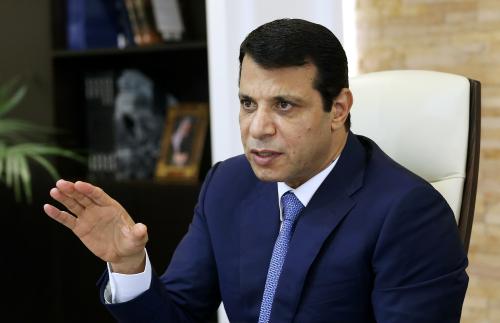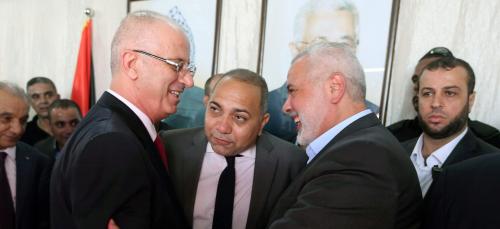Content from the Brookings Doha Center is now archived. In September 2021, after 14 years of impactful partnership, Brookings and the Brookings Doha Center announced that they were ending their affiliation. The Brookings Doha Center is now the Middle East Council on Global Affairs, a separate public policy institution based in Qatar.
This week’s news that Gaza’s Hamas rulers have entered into a new pact with former Fatah strongman Mohammed Dahlan appeared to signal a new phase not only in Palestinian politics but in the wider Palestinian-Israeli and Arab regional arena. What once seemed unthinkable has become a reality, as the balance of power shifts due to the current Gulf Cooperation Council (GCC) crisis with Qatar.
Bad Blood
There is a history of bad blood between Hamas and Dahlan. When the latter presided over Gaza as its internal security chief, he ordered purges against Hamas. Throughout both the Oslo period and the second Palestinian intifada, Dahlan had his security forces arrest and detain Hamas leaders and their cadres. During such incarcerations, allegations emerged that senior Hamas figures were humiliated and even tortured.
In June 2007, Dahlan’s men in Gaza were then subjected to a humiliating rout by Hamas. Senior American officials described President Abbas and the Fatah political leadership in Ramallah as more hindrance than help to Dahlan’s field commanders on the ground in Gaza. At Fatah Council emergency meetings—where Dahlan was absent—the president had to acknowledge that he had no tools left to solve the situation in Gaza. Many of Dahlan’s most trusted lieutenants were literally forced to flee Gaza under the cover of darkness. They were banished and forced to abandon their offices, luxury villas, and vehicles.
Isolation
President Abbas appeared to make Dahlan pay the price for Fatah’s defeat in Gaza. He was subsequently expelled from Fatah and effectively forced into exile in the UAE. In absentia, he then faced corruption charges in an indictment apparently authorized by President Abbas. The feud between the rival Fatah leaders has endured. Hamas in Gaza were also isolated and the people of Gaza suffered. Israel has imposed a decade-long blockade enforced by Egypt. While in the past President Abbas had authorized salary payments of his public servants in the Gaza Strip, this has been reduced. More recently, additional pressure has been evident in the decision by President Abbas to ask Israel to cut electricity supplies to Gazans in order to pressure Hamas. International agencies such as the International Committee of the Red Cross have warned of an impending “systematic collapse” of Gaza’s infrastructure and economy.
Dahlan and Hamas are now on the brink of new era in relations. This means that the deep enmity of the past will have to be set aside as they appear to unite against their common enemy, President Abbas.
Power-sharing
Since the collapse of the National Unity Government (NUG) in 2007, Hamas and Fatah have made countless attempts, usually with Egyptian mediation, to share power over this tiny coastal enclave. Plans for power-sharing in the Gaza Strip have rarely succeeded. Politically, the Fatah wing led by President Abbas, has remained effectively absent from Gaza.
News of a power-sharing agreement between Hamas and Dahlan—entitled the “National Consensus Document for Trust-Building”—initially appeared to cover familiar terrain. Articles address important confidence-building measures required for reconciliation and to an end the state of divide, such as reparation for victims of internecine violence at a projected cost of $50 to 100 million.
Money and Security Talk
The current proposal, however, does offer a different proposition. Firstly, the agreement has already led to the establishment of a joint committee for “Social Solidarity” between Hamas and Dahlan’s Fatah wing. Dahlan’s close ally Samer Mashrawi will work with Hamas leaders in Gaza to offer relief assistance, and poverty alleviation to the local population using funds that will probably be forthcoming from the UAE.
Secondly, Fatah—as led by Mohammed Dahlan—will return to Gaza and will govern on the ground alongside Hamas. This will be a Fatah wing that enjoys the support and patronage of Egypt, the UAE and, indirectly Israel and the United States.
Thirdly, however, the new agreement recognizes that even if Dahlan returns to Gaza, Hamas will retain responsibility for what is termed the “internal security file” and response to any Israeli aggression. What remains deliberately ambiguous, however, is the matter of external security on Gaza’s borders with Israel and Egypt where, in the past, Dahlan’s men ran the show.
Fourthly, this will be a power-sharing arrangement that not only focuses on the challenges of Gaza’s desperate humanitarian and economic situation, but sets its sights on the seat of power held by President Abbas in Ramallah. This poses a direct threat to President Abbas and once again reiterates a view that Dahlan could succeed this ailing leader.
The possibility of this projection of power has already led to speculation that this is a new “Gaza-state” project over which Mohammed Dahlan will preside. Hamas leaders have emphatically ruled this out but they are defending themselves from a position of weakness. They have little choice but to accept Dahlan and the Egyptian-UAE position. Hamas leaders have spun the deal as a step towards national reconciliation and ending the state of divide.
Regional Eclipse
Dahlan’s return to Gaza and the re-emergence of his loyalists over the levers of governance there will have important consequences. Such a scenario would indicate the eclipse of Qatar and Turkey in Gaza and their replacement by the UAE and Egypt. Israel would greet such displacement positively.
Egypt and the UAE are regional state actors that Israel is comfortable with. All three share similar positioning on Hamas and the thematic of counterterrorism. Hamas and Dahlan recognize the pivotal role that Egypt plays.
Egypt already has a technical team in Gaza undertaking an urgent needs assessment to determine priorities for assistance. Hamas is seizing on the opportunity, and in return it is offering Egypt counterterrorism and security assurances—especially as it relates to border monitoring and tackling threats from north Sinai.
Hamas leaders understand that they must rebuild confidence and credibility with the Egyptians. It is also clear that the UAE stands ready to act as the financier of the agreement and plans that seek to improve life for ordinary Gazans and cement the Hamas-Dahlan plan. Under this plan Gaza would be able to have more access to the outside world via Egypt. This could avert a looming humanitarian crisis and offer opportunities for economic recovery.
The United States will be concerned to see the new agreement unfold in Gaza but it will be content to stand back. Washington knows it can rely on Egypt and the UAE to shackle and constrain Hamas in ways that support their own agenda in alignment with Israel. America recognizes that it is better to get el-Sissi’s Egypt rather than an absent President Abbas to spearhead this particular counter-terrorist effort as it relates to Gaza and the north Sinai.










Commentary
Gaza end game?
July 7, 2017